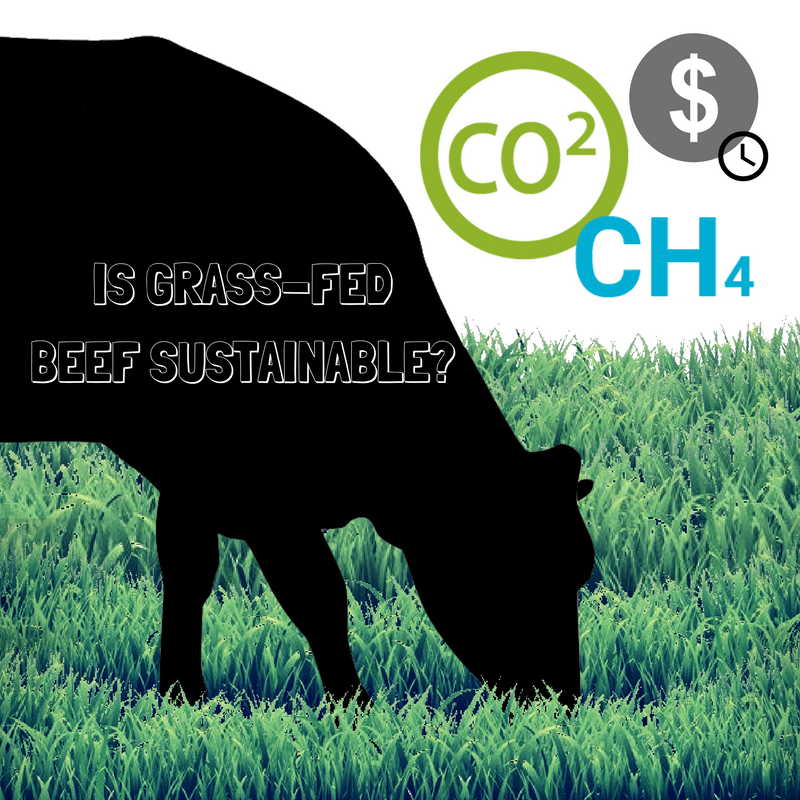By: Brayden Schmidt, University of Saskatchewan Student
Grass fed beef is one of two ways to develop and finish beef cattle prior to slaughter, the other being fed on a mixed, grain and forage diet. The common talk about grass fed beef is what qualifies it to have the title and is it a sustainable practice that will feed the world in the future?
The average grain-fed animal takes 100-150 days to finish on a grain diet at an average daily gain of 3-3.5/lbs a day and is usually slaughtered at 14-15 months of age. A grass-fed animal is typically slaughtered at 22 months of age when only consuming a forage diet because the animal is not able to gain the amount of weight a grain fed animal is. This means that the grass-fed animal is alive and on feed at least 200 days longer than a grain-fed animal. The grass-fed practice takes more days to finish an animal and is not a sustainable method to produce beef when there are already efficient practices being used. As grass-fed cattle are alive a lot longer, they are also giving off a lot more methane. The average bovine produces 55 g of methane a year, or 4.6 g a month, this is another reason that the grass-fed method is not as efficient or sustainable as finishing cattle using a diet that includes grain. If the animal was alive for an additional 7 months, that would add 32.2 g of methane into the atmosphere, per animal. There are many grass-fed operations in the United States as they have areas where there are adequate weather conditions to graze cattle year round. Canada gets much colder in the winter and faces diverse weather conditions, therefore most beef animals in Canada are typically on a grain fed diet so they are able to maintain adequate body condition through the cold months.
Recently in 2016 the Agriculture Marketing Service (AMS), which is a division of the US Department of Agriculture, dropped the official definition of “grass-fed”. The reason for doing this was that they did not believe that they had authority to define and determine what was specifically grass-fed. Why people are paying $2.00-3.00/lb for what potentially could be labelled as falsely grass-fed beef is a concern. Now more so than ever, there are many loopholes that cattle are able to slip through and can be titled as grass-fed beef. The American Grassfed Association states that they audit farmers that produce grass-fed beef annually. This is a beneficial start, although there is going to be a time when it becomes difficult to manage this because grass-fed operations are increasing so rapidly in the United States. Canada does not officially have a regulation or policy that monitors grass-fed beef. Currently in Canada, “grass-fed” means that animals are raised on pasture and are not confined to a feedlot or grain-fed diet. There needs to be an official policy put in place in Canada by the livestock industry that monitors and regulates what can be labelled and credited as grass-fed beef. It would be beneficial to have knowledgeable sources such as livestock educated professionals, veterinarians and ranchers that monitored the labelling. This way there is trust-worthy, livestock educated personal taking care of this, not just government employees that may not be educated when it comes to beef cattle.
[su_spoiler title=”References:” style=”fancy” anchor=”References”]
References
Calderone, J. (2016, March 25). You may want to think twice before buying expensive grass-fed beef. Retrieved October 9, 2017, from http://www.businessinsider.com/grass-fed-claims-beef-bogus-usda-packaging-2016-2.
The Food Revolution Network. (2017). The Truth About Grassfed Beef. (2017, May 12). Retrieved October 10, 2017, from https://foodrevolution.org/blog/the-truth-about-grassfed-beef/.
The Ultimate Guide to Canadian Meat Labels. (2015) Retrieved October 10, 2017, from https://www.realfoodtoronto.com/blog/the-ultimate-guide-to-canadian-meat-labels/.
How much methane does a cow actually produce? (2016, December 13). Retrieved October 9, 2017, from https://muchadoaboutclimate.wordpress.com/2014/10/01/how-much-methane-does-a-cow-actually-produce/.
[/su_spoiler]
 Hello my name is Brayden Schmidt, I am 22 years old and was born and raised in Lumsden, Sk. I am currently enrolled at the University of Saskatchewan where I am AgBusiness. I am passionate about the agriculture and my life is focused around the agriculture industry. I plan on working in the working in the agriculture industry for years to come after I am finished my program. I am looking forward to giving back to society by working hard in the industry and by Agvocating people to provide them with logical facts and knowledge, regarding the way the agriculture industry operates.
Hello my name is Brayden Schmidt, I am 22 years old and was born and raised in Lumsden, Sk. I am currently enrolled at the University of Saskatchewan where I am AgBusiness. I am passionate about the agriculture and my life is focused around the agriculture industry. I plan on working in the working in the agriculture industry for years to come after I am finished my program. I am looking forward to giving back to society by working hard in the industry and by Agvocating people to provide them with logical facts and knowledge, regarding the way the agriculture industry operates.
[su_button url=”https://twitter.com/BraydenSchmidt” style=”glass” background=”#06a3d3″ size=”2″ radius=”round” icon=”icon: twitter” ]@BraydenSchmidt[/su_button]



Thanks for a thought provoking article.
Perhaps a grass fed cow is less efficient in conversion of feed to gain. Has the work been done comparing emissions from a grass fed steer to a feedlot fed one or is this an extrapolation based on time only? Diet should have big implications, as even within the grass fed relm different species can affect emissions.
Also, I don’t think it is fair to look just at steer emissions without looking at the entire system. What is emitted from a feedlot system? Everything that is emitted from the growing, transport, preparing, and feeding of grain should be included, as well as from manure spreading and any emissions from manure stockpiling or in the field. Of course the same is true of grass fed as well.
I like what you say abiut monitoring and labeling, though I suspect that a label just boxes producers in. Most likely a hybrid system of feeding some grain while grazing land is the most sustainable practice when systems level scrutiny is applied. So why not label something like that? Or, probably ideally, not label at all and let the rancher tell the story. In my experience, if you can tell your production story with a label, either you aren’t trying to discover new things or the label is so broad that it is meaningless.
Thanks for the great comment Andy. I agree that there are multiple ways of looking at this issue. Brayden did what was asked of him in the class assignment last fall when it came to writing a blog. The objective of the assignment is to write a blog of 400-600 words. To adequately address the items you raise would required considerably more context and be beyond the scope of the assignment. Full life cycle analysis of issues are complex, requiring substantial research data and time. We have just hired a new beef economist in our department and I’ll pass your comments along to her, encouraging her to consider some research in this area. Sincerely, Stuart